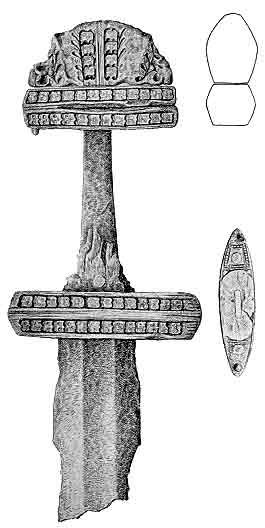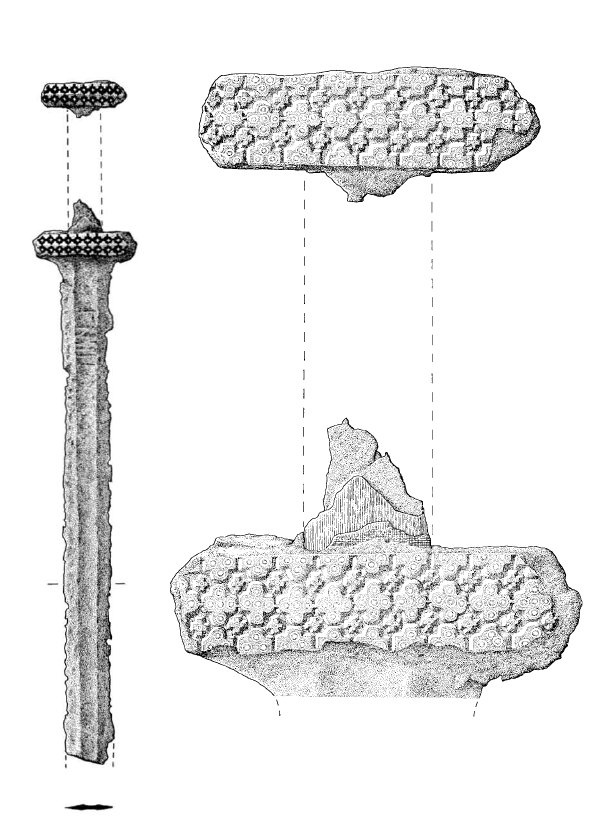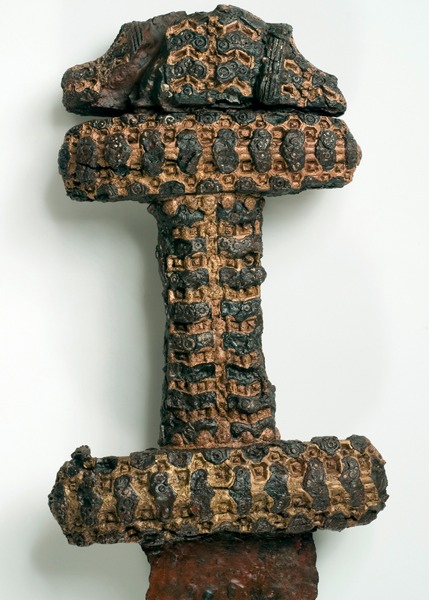| Author |
Message |
|
Victor Genke
|
 Posted: Tue 18 Feb, 2014 1:49 pm Post subject: Viking Swords from Russia and Ukraine Posted: Tue 18 Feb, 2014 1:49 pm Post subject: Viking Swords from Russia and Ukraine |
 |
|
I'd like to share with you a few images of Viking swords displayed in Russian museums.
Swords from Chernaya Mogila (Black Grave) burial mound (Chernigov, Ukraine):

Sword from Mikhailovskoye (Yaroslavl, Russia), burial mound 1, excavations by V. Gorodtsov, 1901:

Ulfberht sword displayed in Novgorod State Historical Museum:

Sword from Gulbishche burial mound (Chernigov, Ukraine), grave of a warrior (cremation). Full length 125 cm, blade length 105 cm. Thus it is the longest sword in Europe of the period.

Gnezdovo (Smolensk, Russia). Burial mound 4, cremation. Ulfberht sword:

|
|
  |
 |
Bryan Heff

|
 Posted: Tue 18 Feb, 2014 2:33 pm Post subject: Posted: Tue 18 Feb, 2014 2:33 pm Post subject: |
 |
|
Those are great pictures, thanks for sharing them. I really like that second picture...the engraving/design work on the pommel and guard are utterly fantastic. Love that sword.
The church is near but the roads are icy. The tavern is far but I will walk carefully. - Russian Proverb
|
|
  |
 |
Greg E

|
 Posted: Tue 18 Feb, 2014 6:30 pm Post subject: Posted: Tue 18 Feb, 2014 6:30 pm Post subject: |
 |
|
|
Thank you for sharing these with us. I too like the sword in the second picture. I wonder what the upper pommel piece was shaped like? Spectacular piece.
|
|
  |
 |
Robin Smith

|
 Posted: Tue 18 Feb, 2014 7:18 pm Post subject: Posted: Tue 18 Feb, 2014 7:18 pm Post subject: |
 |
|
| Greg E wrote: | | Thank you for sharing these with us. I too like the sword in the second picture. I wonder what the upper pommel piece was shaped like? Spectacular piece. |
It appears to be a member of the Petersen type D group... So the pommel would likely have been trilobate with a decoration scheme matching the rest of the hilt
Here are some other examples:


http://www.vikingsword.com/petersen/ptsn070d.html
A very similar sword was found in Donnybrook, also missing its pommel

A furore Normannorum libera nos, Domine
|
|
   |
 |
|
Victor Genke
|
 Posted: Wed 19 Feb, 2014 12:43 pm Post subject: Posted: Wed 19 Feb, 2014 12:43 pm Post subject: |
 |
|
| Bryan Heff wrote: | | Those are great pictures, thanks for sharing them. |
Thanks for the feedback, Brian.
| Robin Smith wrote: | | It appears to be a member of the Petersen type D group... |
You are right, Robin, it's a type D sword.
| Greg E wrote: | | I wonder what the upper pommel piece was shaped like? |
I think it might look like the sword discovered at Fure in 1991:
http://www.uib.no/universitetsmuseet/publikum...e-paa-fure
 Attachment: 71.19 KB Attachment: 71.19 KB

|
|
  |
 |
|
Victor Genke
|
 Posted: Thu 20 Feb, 2014 11:39 am Post subject: Posted: Thu 20 Feb, 2014 11:39 am Post subject: |
 |
|
Another photo of the sword from Mikhailovskoye.
 Attachment: 104.31 KB Attachment: 104.31 KB

|
|
  |
 |
Shahril Dzulkifli

|
 Posted: Thu 27 Feb, 2014 7:59 am Post subject: Viking Swords from Russia and Ukraine Posted: Thu 27 Feb, 2014 7:59 am Post subject: Viking Swords from Russia and Ukraine |
 |
|

Seems to me like either somebody had flipped over the tang of the Ulfberht sword's blade or it has been flipped over following its discovery.
“You have power over your mind - not outside events. Realize this, and you will find strength”
- Marcus Aurelius
|
|
  |
 |
|
O. Stockhaus
Location: Stockholm, Sweden Joined: 29 Jan 2014
Posts: 7
|
 Posted: Thu 27 Feb, 2014 8:57 am Post subject: Posted: Thu 27 Feb, 2014 8:57 am Post subject: |
 |
|
|
Actually, bending the sword as part of a burial is an ancient costum that dates back to the bronze age in Scandinavia. In order for the sword to follow its' owner into the next world, the sword also had to die, since nothing living can pass into the realm of the dead. The bending is a way to ritually kill the sword, allowing its' master to use it in the next life.
|
|
  |
 |
|
Jeffrey Faulk
|
 Posted: Thu 27 Feb, 2014 1:48 pm Post subject: Posted: Thu 27 Feb, 2014 1:48 pm Post subject: |
 |
|
If the whole thing had been ceremonially 'killed', one would expect the bend to cover a little more of the blade rather than this abrupt right-angle bend short of the lower guard. In the original post there's an excellent example, one that's bent in a semi-circle. I can see this particular one being an accidental bend during excavation or discovery-- someone trips over a bit of metal poking out of the ground, they take a closer look and it's a whole bloomin' sword.
This is somewhat of an aside, but I thought that the ceremonial 'killing' of weapons was a late Iron Age thing, not so much Viking Period? Enlightenment is appreciated 
|
|
  |
 |
Luka Borscak

|
 Posted: Thu 27 Feb, 2014 3:28 pm Post subject: Posted: Thu 27 Feb, 2014 3:28 pm Post subject: |
 |
|
|
Many viking age swords were obviously ritually killed. I agree though that this one looks to be damaged by accident...
|
|
  |
 |
Harry Marinakis

|
 Posted: Thu 27 Feb, 2014 5:22 pm Post subject: Posted: Thu 27 Feb, 2014 5:22 pm Post subject: |
 |
|
|
THANK YOU VICTOR
|
|
  |
 |
|
Scott Woodruff
|
|
  |
 |
|
O. Stockhaus
Location: Stockholm, Sweden Joined: 29 Jan 2014
Posts: 7
|
 Posted: Tue 04 Mar, 2014 2:58 am Post subject: Posted: Tue 04 Mar, 2014 2:58 am Post subject: |
 |
|
[quote=".
This is somewhat of an aside, but I thought that the ceremonial 'killing' of weapons was a late Iron Age thing, not so much Viking Period? Enlightenment is appreciated  [/quote] [/quote]
Ritual bending is often found in context with fire burials. In later burials, particularly the unburnt chamber graves of Birka, the sword is put in the grave undamaged. This suggests, as you say, that the sword-killing, together with fire burials, is a remnant of a much older tradition. The sword killing itself dates back to the bronze age.
|
|
  |
 |
|
Scott Woodruff
|
 Posted: Wed 05 Mar, 2014 4:17 pm Post subject: Posted: Wed 05 Mar, 2014 4:17 pm Post subject: |
 |
|
|
The Gulbishche sword is indeed covered in Kirpichnikov. Close inspection of the photo shows that the guards are decorated with numerous pits, making this one a type E rather than a D.
|
|
  |
 |
Robin Smith

|
 Posted: Wed 05 Mar, 2014 5:40 pm Post subject: Posted: Wed 05 Mar, 2014 5:40 pm Post subject: |
 |
|
| Scott Woodruff wrote: | | The Gulbishche sword is indeed covered in Kirpichnikov. Close inspection of the photo shows that the guards are decorated with numerous pits, making this one a type E rather than a D. |
No, I'd disagree. The pits on type E are done in a different way.. They are regular and rounded. Here what you have is sculpted depressions (a feature of type D) that are surrounded by ring and dot decoration (another feature found on some type D).
The Gnezdovo Burial Mound 4 sword at the bottom of the post is an example of a type E.
A furore Normannorum libera nos, Domine
|
|
   |
 |
|
Victor Genke
|
 Posted: Thu 06 Mar, 2014 11:58 am Post subject: Posted: Thu 06 Mar, 2014 11:58 am Post subject: |
 |
|
Items from the State Historical Museum in Moscow, Russia.
The Black Grave pair of swords from different angles:



Unidentified swords, including a ritually killed one:




|
|
  |
 |
|
Ralph Grinly
|
 Posted: Thu 06 Mar, 2014 9:29 pm Post subject: Posted: Thu 06 Mar, 2014 9:29 pm Post subject: |
 |
|
Maybe I'm being a trifle cynical - but there is a tendency in archaeology to label anything that doesn't have an immediately obvious use or explanation as "Ritual" , at least until a more rational reason comes along with further study. There could be a very "practical' reason for bending swords before including them in their owner's graves. They were , at the time, valuable items of the owners that the family decided should accompany him in death. What better way to ensure that said sword STAYED with the owner and wasn't dug up at a later date by a thief than to bend it all out of shape and therefore render the sword useless as a weapon ? It's one *possible* explanation 
|
|
  |
 |
|
Scott Woodruff
|
 Posted: Thu 10 Apr, 2014 9:58 am Post subject: Posted: Thu 10 Apr, 2014 9:58 am Post subject: |
 |
|
Robin, I see what you mean. Thank you for pointing that out.
Edit: Robin, I was confused, I was talking about the Gulbische sword being a type E, while the original question you answered was about the Mikhailovskoye sword, which does indeed look like an a typical D to me as well.. What is your opinion on the Gulbische sword?
|
|
  |
 |
|
Uwe Zankl
Location: Bavaria, Germany Joined: 28 Dec 2010
Posts: 5
|
 Posted: Sun 27 Jul, 2014 3:15 pm Post subject: Posted: Sun 27 Jul, 2014 3:15 pm Post subject: |
 |
|
| Ralph Grinly wrote: | Maybe I'm being a trifle cynical - but there is a tendency in archaeology to label anything that doesn't have an immediately obvious use or explanation as "Ritual" , at least until a more rational reason comes along with further study. There could be a very "practical' reason for bending swords before including them in their owner's graves. They were , at the time, valuable items of the owners that the family decided should accompany him in death. What better way to ensure that said sword STAYED with the owner and wasn't dug up at a later date by a thief than to bend it all out of shape and therefore render the sword useless as a weapon ? It's one *possible* explanation  |
Hi
I totally agree...and there are many examples on history and religion where practical behaviour was or had to be mystified in order to reach the target group! Like...why do Arabs and Jews do not eat pigs...and why do they slaughter in a certain way. The avarage Joe back then would have simply not understood what missing veterinarians and cooling facilities will do to pig meat very quickly...History is full of those examples.
cheers
Uwe
PS: Many swords were also found intact...so no "cast in stone" relegious behaviour.
|
|
  |
 |
|
|

